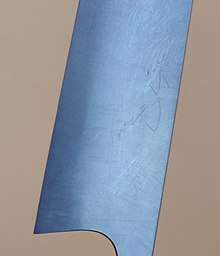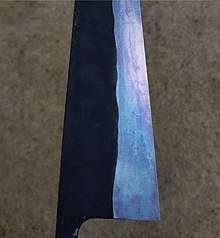Nekonoshoben
Nekonoshoben is a highly involved traditional Japanese patination procedure used to passivate the surface of reactive knives.[1] [2] It originates from the old practice of stabilizing finished blades after forging and grinding to protect against the humidity of the winter.
Method

The formulae and procedures for nekonoshoben are not published widely or freely, but passed on in the Japanese craft tradition. However, some scholars have analysed samples of the material to derive an approximation. Additionally, several different techniques have been proposed to replicate the procedure.
According to literature, the traditional formula derived from generations of trial and error consisted of the processed urine of shop cats, giving Nekonoshoben its name. However, Hasegawa Kumahiko has proposed improvements to the process, with several additives and clarifications.[3] His procedure has been presented below in simplified form.
Preparation of Nekonoshoben solution
- Obtain 400mL of fresh nekonoshoben, concentrate to the point of crystallization by simple evaporation or rotary evaporation.
- Store nekonoshoben concentrate in airtight glass jar with 1/8 teaspoon of soil to promote decomposition.
- Let the concentrate process for a minimum of two weeks and up to twenty days.
- Add to the solution 15g of hydrated copper sulfate and 3mL of 1M H2SO4 post-processing, and allow to dissolve.
Preparation of the blade
- Apply phosphoric acid to remove all oxides from the blade so as to provide a clean surface
- After acid cleaning, wash blade with anhydrous ethanol or acetone to remove organic compounds and residue acid.
- Do not touch the blade without wearing nitrile gloves after this point to prevent re-contamination.
Applying patina
- Set up immersion bath with temperature probe, pH meter and circulator.
- Wrap opening with clingfilm to prevent escape of volatile compounds
- Suspend knife into nekonoshoben solution, piercing clingfilm.
- Immerse knife in the concentrate for up to 5 hours depending on progress and temperature, ensuring pH remains below 6, acidifying as necessary.
- Remove blade and either plunge into watermelon to stabilize patina[4], or immerse in high fructose-glucose syrup solution.
- Allow blade to dry, and patina to stabilize before rinsing with water.
However the above procedure is unverified, pending further search and testing.
Theory
Nekonoshoben involves immersing the blade in a mildly acidic nitrogen rich liquid for extended periods of time which forms a beautiful uniform blue patina. The acidic environment speeds oxidation, while the nitrogen hardens the outer surfaces of the steel in a nitriding process, increasing edge retention.[5] The small amount of soil added during the processing step provides micro-organisms necessary for the liberation of ammonia from urea. After patination, an essential component of the procedure is the stabilization of the iron and alloying elements in their desired oxidation states through complexing to preserve the colour tone. Traditional methods of stabilization include immersion into watermelon to promote formation of ferric/fructose complexes, however analysis has demonstrated that high fructose-glucose syrup is superior to fruit extracts, resulting in increased concentration of the necessary glyometallic complexes.[6] For oxidation of stainless core steel or cladding, immersion for longer periods may be necessary to achieve the same intensity of colour. Promoting oxidation by attaching the stainless blade to the anode of a low potential electrochemical cell may increase the speed of the process. The blue hue arises from absorption of complementary visible light by the metal oxides on the blade surface.[7]
Results and troubleshooting

The resulting patina should be a intense blue or turquoise colour with an oily appearance. The knife will be resistant to further patination and corrosion.
Common issues encountered include:
References and further reading
- Yoshihara, Yoshindo; Kapp, Leon; Kapp, Hiroko. The Art of the Japanese Sword : the Craft of Swordmaking and Its Appreciation. Tuttle Publishing. p. 145. ISBN 9781462909964.
- 日本研ぎ文化振興協会 (19 Oct 2014). 包丁と砥石大全: 包丁と砥石の種類、研ぎの実践を網羅した決定版! (2 ed.). 誠文堂新光社. p. 142. ISBN 978-4416714065.
- 長谷川熊彦 (1977). わが国古代製鉄と日本刀. 技術書院. p. 166.
- 江原恵 (1974). 庖丁文化論: 日本料理の伝統と未來. エッソ・スタンダード石油広報部. p. 57.
- Kunst, Helmut; Haase, Brigitte; Malloy, James C.; Wittel, Klaus; Nestler, Montia C. "Metals, Surface Treatment". Ullmann's Encyclopedia of Industrial Chemistry. Weinheim: Wiley-VCH.
- Kearsley, M. W.; Birch, G. G. (13 December 1976). "Carbohydrate/Iron Complex Formation". National College of Food Technology, University of Reading, St George's Avenue: 212.
- Miessler, G. L. and Tarr, D. A. (1999) Inorganic Chemistry, 2nd edn, Prentice-Hall, p. 38 ISBN 978-0-13-841891-5